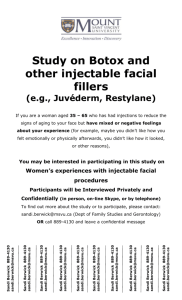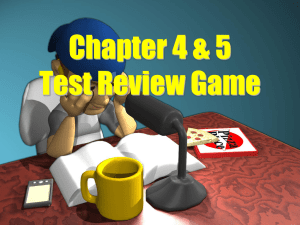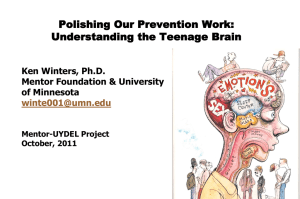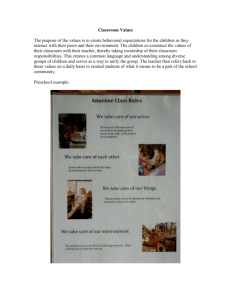Autism - West Ada School District
advertisement
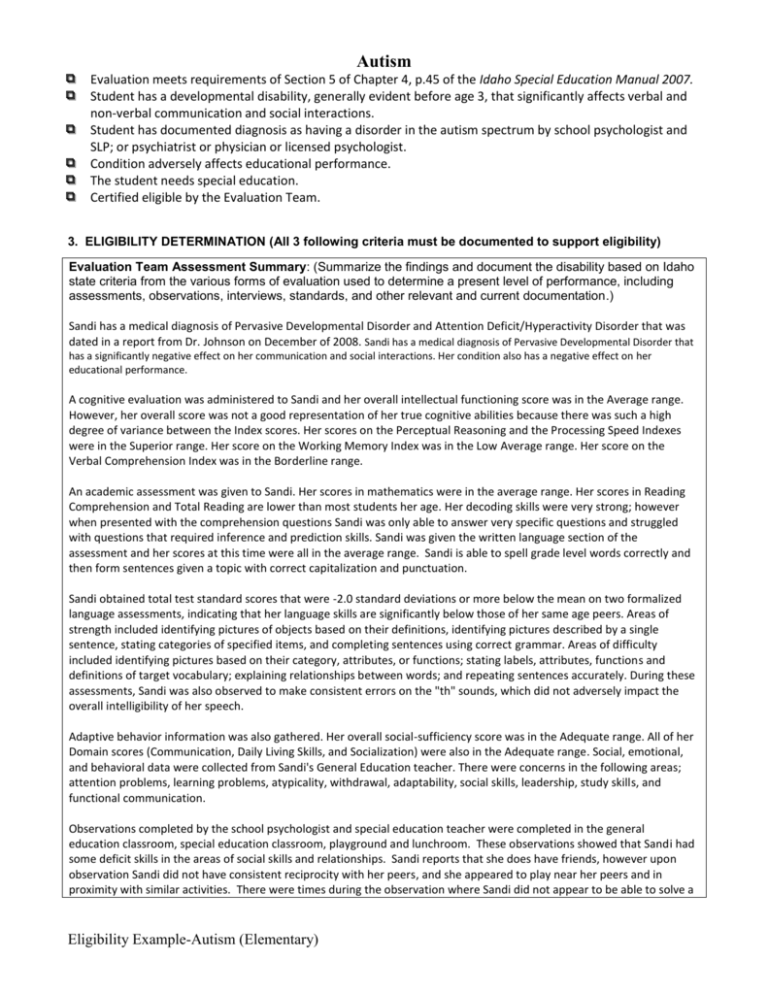
Autism Evaluation meets requirements of Section 5 of Chapter 4, p.45 of the Idaho Special Education Manual 2007. Student has a developmental disability, generally evident before age 3, that significantly affects verbal and non-verbal communication and social interactions. Student has documented diagnosis as having a disorder in the autism spectrum by school psychologist and SLP; or psychiatrist or physician or licensed psychologist. Condition adversely affects educational performance. The student needs special education. Certified eligible by the Evaluation Team. 3. ELIGIBILITY DETERMINATION (All 3 following criteria must be documented to support eligibility) Evaluation Team Assessment Summary: (Summarize the findings and document the disability based on Idaho state criteria from the various forms of evaluation used to determine a present level of performance, including assessments, observations, interviews, standards, and other relevant and current documentation.) Sandi has a medical diagnosis of Pervasive Developmental Disorder and Attention Deficit/Hyperactivity Disorder that was dated in a report from Dr. Johnson on December of 2008. Sandi has a medical diagnosis of Pervasive Developmental Disorder that has a significantly negative effect on her communication and social interactions. Her condition also has a negative effect on her educational performance. A cognitive evaluation was administered to Sandi and her overall intellectual functioning score was in the Average range. However, her overall score was not a good representation of her true cognitive abilities because there was such a high degree of variance between the Index scores. Her scores on the Perceptual Reasoning and the Processing Speed Indexes were in the Superior range. Her score on the Working Memory Index was in the Low Average range. Her score on the Verbal Comprehension Index was in the Borderline range. An academic assessment was given to Sandi. Her scores in mathematics were in the average range. Her scores in Reading Comprehension and Total Reading are lower than most students her age. Her decoding skills were very strong; however when presented with the comprehension questions Sandi was only able to answer very specific questions and struggled with questions that required inference and prediction skills. Sandi was given the written language section of the assessment and her scores at this time were all in the average range. Sandi is able to spell grade level words correctly and then form sentences given a topic with correct capitalization and punctuation. Sandi obtained total test standard scores that were -2.0 standard deviations or more below the mean on two formalized language assessments, indicating that her language skills are significantly below those of her same age peers. Areas of strength included identifying pictures of objects based on their definitions, identifying pictures described by a single sentence, stating categories of specified items, and completing sentences using correct grammar. Areas of difficulty included identifying pictures based on their category, attributes, or functions; stating labels, attributes, functions and definitions of target vocabulary; explaining relationships between words; and repeating sentences accurately. During these assessments, Sandi was also observed to make consistent errors on the "th" sounds, which did not adversely impact the overall intelligibility of her speech. Adaptive behavior information was also gathered. Her overall social-sufficiency score was in the Adequate range. All of her Domain scores (Communication, Daily Living Skills, and Socialization) were also in the Adequate range. Social, emotional, and behavioral data were collected from Sandi's General Education teacher. There were concerns in the following areas; attention problems, learning problems, atypicality, withdrawal, adaptability, social skills, leadership, study skills, and functional communication. Observations completed by the school psychologist and special education teacher were completed in the general education classroom, special education classroom, playground and lunchroom. These observations showed that Sandi had some deficit skills in the areas of social skills and relationships. Sandi reports that she does have friends, however upon observation Sandi did not have consistent reciprocity with her peers, and she appeared to play near her peers and in proximity with similar activities. There were times during the observation where Sandi did not appear to be able to solve a Eligibility Example-Autism (Elementary) break down in social interactions or understand the slang that was used by the other students. She did not demonstrate skills to gather clarification or get more information. Sandi stated that she likes her friends and thinks that her friends like her as well. Adverse Effect on Educational Performance: (Indicate evidence of the effect of the disability on the student’s performance.) Sandi's low academic skills in the area of reading make it difficult for her to keep up with her peers in the General Education setting without some additional support provided. Her reading skills hinder Sandi because a lot of the academic areas outside of reading require her to be able to read and comprehend the information to answer math, writing, science and social studies questions and assessments. When Sandi gets frustrated due to the lack of ability in reading this causes an increase in the behaviors and make it very difficult for her to concentrate in the classroom as well as disrupt her learning and the learning of other students. Sandi's difficulties in the area of language adversely affect her ability to communicate effectively across all school settings, including in the classroom and with her peers. Due to her language skills she is unable to follow and give directions, to understand grade level material, to participate in classroom discussions at a level equal to that of her same grade peers, and to otherwise use language to gather/clarify information at an appropriate level. These skills also prevent her from interacting with her peers to maintain conversations and repair social breakdowns during conversations. Need for Specially Designed Instruction: (Describe resources necessary to support the student to access and progress in the general education curriculum.) Sandi's low academic skills in the area of reading make it difficult for her to keep up with her peers in the General Education setting without some additional support provided. Sandi has demonstrated that she needs to have instruction presented in a small group to work on building her comprehension skills. She needs to opportunity to have discrete presentation of information along with increased opportunities to practice the skill with immediate feedback to reduce the practice of errors and decrease frustration. In the general education classroom, Sandi does a better job of keeping up and staying focused when assisted by an assistant/teacher during reading, writing, and math. She has a need for accommodations that include pointing out the relevant information in text, having clarifying questions to check for understanding and to help redirect her to problem solving strategies when she begins to get frustrated. If Sandi is frustrated she often shuts down and does not work. Based on the results of this evaluation, Sandi also requires specially designed instruction in a small group setting in the area of language that provides multiple opportunities for vocabulary development and additional language building skills, in order to continue to progress toward meeting state and district standards. Sandi will also need to have small group instruction with leveled support that starts with a modeled role play group and fades to contrived settings and then natural settings to help her develop her social skills in problem solving, repairing a social break down, and gathering information for clarification. 4. ELIGIBILITY DETERMINATION In consideration of the reported information, the evaluation team finds the student [ x] is [ ] is not eligible under the category Autism_. Eligibility Example-Autism (Elementary)

